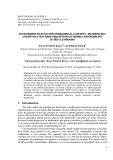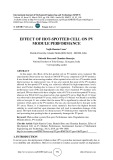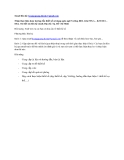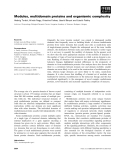NATIONAL UNIVERSITY OF HO CHI MINH CITY UNIVERSITY OF INFORMATION TECHNOLOGY FACULTY OF COMPUTER ENGINEERING
CHAPTER 4: STRUCTURAL MODELING
Lecturer: Ho Ngoc Diem
1
Agenda
Introduction Modules and hierarchical structure Fundamental concepts Structural modeling (Gate & Switch-level modeling) Dataflow modeling (Expression) Behavioral modeling Tasks and Functions State machines Testbench and verification
Chapter 1: Chapter 2: Chapter 3: Chapter 4: Chapter 5: Chapter 6: Chapter 7: Chapter 8: Chapter 9: Chapter 10: VHDL introduction
2
Content Chapter 4: A – Overview What is structural modeling Primitive gates Switches User-defined primitives B – Examples Combinational Circuit Sequential Circuit
3
A – Overview Primitive Gates, Switches, User-defined primitives
4
Verilog model for hardware design
Verilog design
RTL Design
- Primitive switch, gate - User defined primitive
-Continuous assignment (assign) - Expression (operators)
- Procedural assignment - initial, always block - Conditional statement…
There are different ways of modeling a hardware design. Choose an appropriate model to design Combinational or Sequential Circuit. Some books do not classify Dataflow modeling as a separate modeling
Gate/Switch level modeling Dataflow modeling Behavioral modeling
type.
5
Structural model
When Verilog was first developed (1984) most logic simulators
operated on netlists
Netlist: a list of gates and show how they are connected
together
A natural representation of a digital logic circuit Not the most convenient approach to express the test benches
6
Structural model
Structural - Explicit structure of the circuit - How a module is composed as an interconnection of more primitive
modules or components
- E.g. Each logic gate initially instantiated and connected to others In Verilog, a structural model consists of: - List of connected components - Like schematics, but using text: netlist - Boring when write, and hard to decode - Essential without integrated design tools
7
Structural model
Structural Models are built from gate primitives,
switches, and other modules
Describe the logic circuit using logic gates
8
Primitive gates 12 primitive logic gates predefined in the Verilog HDL
Advantanges:
Gates provide a much closer one-to-one mapping between the actual circuit and the model. There is no continuous assignment equivalent to the bidirectional transfer gate.
9
Primitive gates And/Or/Nand/Nor/Xor/Xnor
Multiple scalar inputs
One scalar output
The first terminal in the list of gate terminals is an output and the other terminals are inputs Terminal list
wire OUT, IN1, IN2; // basic gate instantiations.
Verilog automatically instantiates the appropriate gate.
and a1(OUT, IN1, IN2);
// More than two inputs; 3 input nand gate
nand na1(OUT, IN1, IN2);
nand na1_3inp(OUT, IN1, IN2, IN3);
or or1(OUT, IN1, IN2);
// gate instantiation without instance name
nor nor1(OUT, IN1, IN2);
and (OUT, IN1, IN2); // legal gate instantiation
xor x1(OUT, IN1, IN2);
10
xnor nx1(OUT, IN1, IN2);
Primitive gates
Buf/Not Gates
One scalar input
One or more scalar outputs
// basic gate instantiations.
The last terminal in the port list is connected to the input
buf b1(OUT1, IN);
not n1(OUT1, IN);
// More than two outputs
buf b1_2out(OUT1, OUT2, IN);
// gate instantiation without instance name
not (OUT1, IN); // legal gate instantiation
11
Primitive gates Bufif/notif
Gates with an additional control signal on buf and not gates
Propagate only if control signal is asserted.
bufif1 b1 (out, in, ctrl); bufif0 b0 (out, in, ctrl);
notif1 n1 (out, in, ctrl);
notif0 n0 (out, in, ctrl);
Propagate z if their control signal is de-asserted
12
Primitive gates Array of Instances
wire [7:0] OUT, IN1, IN2;
nand n_gate[7:0](OUT, IN1, IN2);
// This is equivalent to the following 8 instantiations nand n_gate0(OUT[0], IN1[0], IN2[0]); nand n_gate1(OUT[1], IN1[1], IN2[1]); nand n_gate2(OUT[2], IN1[2], IN2[2]); nand n_gate3(OUT[3], IN1[3], IN2[3]); nand n_gate4(OUT[4], IN1[4], IN2[4]); nand n_gate5(OUT[5], IN1[5], IN2[5]); nand n_gate6(OUT[6], IN1[6], IN2[6]); nand n_gate7(OUT[7], IN1[7], IN2[7]);
The instances differ from each other only by the index of the vector to which they are connected
13
Primitive gates Example: Gate-level multiplexer
// Module 4-to-1 multiplexer.
// Port list is taken exactly from the I/Odiagram.
module mux4_to_1 (out, i0, i1, i2, i3, s1, s0);
// Port declarations from the I/O diagram
output out;
input i0, i1, i2, i3;
input s1, s0;
4-to-1 Multiplexer
14
Primitive gates Example: Gate-level multiplexer // Internal wire declarations
wire s1n, s0n;
wire y0, y1, y2, y3;
// Gate instantiations
// Create s1n and s0n signals.
not (s1n, s1);
not (s0n, s0);
// 3-input and gates instantiated
and (y0, i0, s1n, s0n);
and (y1, i1, s1n, s0);
and (y2, i2, s1, s0n);
and (y3, i3, s1, s0);
// 4-input or gate instantiated
or (out, y0, y1, y2, y3);
Logic Diagram for 4-to-1 Multiplexer
endmodule
15
Switches
There are two kinds of switch: * MOS switches :
cmos, nmos, pmos, rcmos, rnmos, rpmos
* Bidirectional pass switches:
tran, rtran, tranif1, rtranif1, tranif0, rtranif0
Advantages:
is no continuous assignment equivalent to the
- Gates provide a much closer one-to-one mapping between the actual circuit and the model. - There bidirectional transfer gate.
16
Switches
when “off”
nmos when “on”
rnmos when “on”
MOS switches: nmos, pmos, rnoms, rpmos Unidirectional channel for data, similar to bufif gate nmos rnmos
R
R
CONTROL
DATA
when “off”
rpmos when “on”
pmos rpmos
CONTROL
R
R
DATA
Ex: nmos n1 (out, data, control) pmos when “on”
Ex: pmos p1 (out, data, control) 17
Switches
MOS Switches: cmos, rcmos
n_control
cmos when on
rcmos when on
when “off”
R
R
cmos rcmos
out
in
p_control
cmos (out, in, n_control, p_control)
18
Switches
Bidirectional pass switches
tranif0, tranif1, rtranif0, rtranif1: block signal when turn off,
pass signal when turn on Ex: tranif0 (inout1, inout2, control) tran, rtran: always pass signal Ex: tran (inout1, inout2) Terminals be scalar nets or bit-select of vector nets
19
Switches Bidirectional pass switches
rtran R
tran R
tran, rtran
inout2
inout1
control
tranif0
rtranif0
tranif0 , rtranif0
R
R
inout2
inout1
rtranif1
tranif1, rtranif1
control
R
tranif1 R
inout2
inout1
20
Switches
Ref “Verilog digital system design”, Zainalabedin Navabi for
design examples at switch level
21
Strength modeling
Allows specification of drive strength for primitive gate outputs
and nets.
Gate output or net signal strength values are specified in a set of parenthesis that include a strength value for logic 0 and one for logic 1.
Drive strengths for logic 0 (strength0): supply0, strong0, pull0, weak0, highz0 Drive strengths for logic 1 (strength1): supply1, strong1, pull1, weak1, highz1 Charge strengths, representing the strength of a capacitive net:
large, medium, small
22
Strength modeling Drive strength values of primitive gate outputs
Ex:
23
Strength modeling Strength values of nets
Strength0
Strength1
Drive strength
Charge strength
24
Strength modeling
Strength level
The stronger signal shall dominate all the weaker drivers and determine the result.
25
Gate & Net delays • Rise, Fall, and Turn-off Delays
Rise delay
Fall delay
Turn-off delay
1, 0, x
z
Note: If a value changes to x, the minimum of the three delays is considered
26
Gate & Net delays
• Rise, Fall, and Turn-off Delays
- If only one delay is specified, this value is used for all transitions.
- If two delays are specified, they refer to the rise and fall delay values.
The turn-off delay is the minimum of the two.
- If all three delays are specified, they refer to rise, fall, and turn-off delay values.
- If no delays are specified, the default value is zero.
and #(5) a1(out, i1, i2); //Delay of 5 for all transitions
Example:
and #(4,6) a2(out, i1, i2); // Rise = 4, Fall = 6
bufif0 #(3,4,5) b1 (out, in, control); // Rise = 3, Fall = 4, Turn-off = 5
27
Gate & Net delays
• Min/Typ/Max values
For each type of delay three values, min/typ/max, can be specified.
Min/typ/max values: model devices whose delays vary within a [min max] range because of the IC fabrication process variations.
min The minimum delay value that the designer expects the gate to have
typ The typical delay value that the designer expects the gate to have
max The maximum delay value that the designer expects the gate to have
Method of choosing a min/typ/max value may vary for different simulators or operating systems
Min, typ, or max values can be chosen at Verilog run time.
28
// One delay
Gate & Net delays • Min/Typ/Max
// mindelays, delay= 4
values
// typdelays, delay= 5
// maxdelays, delay= 6
and #(4:5:6) a1(out, i1, i2);
// Two delays
// mindelays, rise= 3, fall= 5, turn-off = min(3,5)
// typdelays, rise= 4, fall= 6, turn-off = min(4,6)
// maxdelays, rise= 5, fall= 7, turn-off = min(5,7)
and #(3:4:5, 5:6:7) a2(out, i1, i2);
// Three delays
// mindelays, rise= 2 fall= 3 turn-off = 4
// typdelays, rise= 3 fall= 4 turn-off = 5
// maxdelays, rise= 4 fall= 5 turn-off = 6
and #(2:3:4, 3:4:5, 4:5:6) a3(out, i1,i2);
29
Gate & Net delays
30
Built-in Gate & Switch
A gate/switch instance declaration consists of:
Ex: nand (pull0, pull1) #(3, 5) n1 [7:0] (w, a, b, c)
31
User-Defined Primitives
• The set of predefined gate primitives by designing and
specifying new primitive elements
• Instances of these new UDPs can be used in exactly the same
manner as the gate primitives
• Way to define combinational and sequential elements using
a truth table
• Each UDP has exactly one output, which can be in one of
three states: 0, 1, or x.
• Often simulate faster than using expressions, collections of
primitive gates, etc.
• Gives more control over behavior with X inputs
• Most often used for specifying custom gate libraries
32
0 1 ? : 1 ; // ? = 0 1 x 0 0 ? : 0 ; 1 ? 1 : 1 ; 1 ? 0 : 0 ; x 0 0 : 0 ; x 1 1 : 1 ;
output mux; input control, dataA, dataB; table // control dataA dataB mux endtable endprimitive
33
Example: Combinational UDPs primitive multiplexer (mux, control, dataA, dataB); output mux; input control, dataA, dataB; table // control dataA dataB mux 0 1 0 : 1 ; 0 1 1 : 1 ; 0 1 x : 1 ; 0 0 0 : 0 ; 0 0 1 : 0 ; 0 0 x : 0 ; 1 0 1 : 1 ; 1 1 1 : 1 ; 1 x 1 : 1 ; 1 0 0 : 0 ; 1 1 0 : 0 ; 1 x 0 : 0 ; x 0 0 : 0 ; x 1 1 : 1 ; endtable endprimitive
User-Defined Primitives Example: Level-sensitive sequential UDPs
primitive latch (q, clock, data); output q; reg q; input clock, data; table // clock data q q+ 0 1 : ? : 1 ; 0 0 : ? : 0 ; 1 ? : ? : - ; // - = no change endtable endprimitive
34
User-Defined Primitives Example: Edge-sensitive sequential UDPs
primitive d_edge_ff (q, clock, data); output q; reg q; input clock, data; table // obtain output on rising edge of clock // clock data q q+ (01) 0 : ? : 0 ; (01) 1 : ? : 1 ; (0?) 1 : 1 : 1 ; (0?) 0 : 0 : 0 ; // ignore negative edge of clock (?0) ? : ? : - ; // ignore data changes on steady clock ? ? : ? : - ; // - = no change endtable endprimitive
35
User-Defined Primitives Initial statement in UDPs and instances
module dff (q, qb, clk, d); input clk, d; output q, qb; dff1 g1 (qi, clk, d); buf #3 g2 (q, qi); not #5 g3 (qb, qi); endmodule
primitive dff1 (q, clk, d); input clk, d; output q; reg q; initial q = 1'b1; table // clk d q q+ r 0 : ? : 0 ; r 1 : ? : 1 ; f ? : ? : - ; ? * : ? : - ; endtable endprimitive
36
B – Examples Combinational Circuit & Sequential Circuit
37
Combinational Circuit
Outputs are functions of the current inputs Logic without state variables No clock involved Examples
o multiplexers o decoders o encoders o adders
38
Example: xor xor
The instantiated gates are always active xor gate already exists as a built-in (so really no need to define it)
39
Example: mux 4-to-1
40
Example: 2-to-4 decoder
41
Example: Full adder 1-bit
t1
t2
t3
Full adder 1-bit
Or
Full adder 1-bit
< student write code!>
42
Example: 4-bit ripple carry full adder
43
Sequential Circuit
A feedback path The state of the sequential circuits The state transition - synchronous circuits - asynchronous circuits
Example: Latch, Flip-flop, Register, Counter, State machine, Processor…
44
Example: SR latch
Clocked Set-Reset (SR) Latch : (1) State can change only when clock is high (2) Potential non-derterministic behavior if both input Sbar and Rbar
are 0
45
Example: SR latch
module clockedSR_latch(Q, Qbar, Sbar, Rbar, clk); // Port declarations output Q, Qbar; input Sbar, Rbar, clkbar; wire X, Y ; // Gate declarations not a(clkbar, clk); or r1(X, Sbar, clkbar); or r2(Y, Rbar, clkbar); nand n1(Q, X, Qbar); nand n2(Qbar, Y, Q); end module
46
Example: D flip-flop
Negative edge-triggered D flip-flop
sbar
s
cbar
clear
q
clkbar
clk
qbar
r
rbar
d
Negative edge-triggered D-flipflop implemented using 3 SR latches
47
Example: D flip-flop
Gate-level D-flipflop (1) Negative edge-triggered (2) Made from 3 SR-latches (see circuit)
Extremely important module – it is the fundamental unit of computer memory!
Negative edge-triggered D flip-flop module edge_dff(q, qbar, d, clk, clear); output q,qbar; input d, clk, clear; wire s, sbar, r, rbar,cbar; not (cbar, clear); not (clkbar, clk); // Input latches nand (sbar, rbar, s); nand (s, sbar, cbar, clkbar); nand (r, rbar, clkbar, s); nand (rbar, r, cbar, d); // Output latch nand (q, s, qbar); nand (qbar, q, r, cbar); endmodule
48
Example: Register
Register 4-bit
module register4bits( dataOut, dataIn, enable, clock, clear ); // Inputs and outputs output [3:0] dataOut; input [3:0] dataIn; input enable, clock, clear; // 4 D-flipflops edge_dff ff0( dataOut[0], dataIn[0], enable, clock, clear ); edge_dff ff1( dataOut[1], dataIn[1], enable, clock, clear ); edge_dff ff2( dataOut[2], dataIn[2], enable, clock, clear ); edge_dff ff3( dataOut[3], dataIn[3], enable, clock, clear );
49
endmodule
Example: T flip-flop
T (Toggle) flip-flop
Negative edge-triggered T-flipflop implemented using a D-flipflop and an inverter gate – toggles every clock cycle
50
Example: 4-bit ripple counter
51




































